Tessa Satherley, Economic Policy
Key issue
The 47th Parliament begins with a bipartisan commitment to net zero by 2050, in a world pursuing decarbonisation. To advance this goal, Australia will need to manage substantial structural changes in our economy, including our trade, our energy systems and employment in the mining and energy sectors – all while trying to ensure households and industry have reliable and affordable energy supplies. Many of these challenges will manifest in difficult policy decisions, such as which energy sources and technologies to invest in; whether to authorise new gas development or coal mines; and how best to manage the necessary trade-offs in any course of action.
This article considers the role of coal and gas in
Australia’s economy, and summarises recent relevant policy and legislation. It
provides background on the 2022 east coast energy price crisis, and outlines some
of the policy challenges for the 47th Parliament related to coal and gas employment,
energy affordability, and environmental accountability in a world seeking to
limit climate change (see the article, ‘Climate Change and Emissions Reduction’ in this Briefing book).
Coal and gas in the Australian economy today
The coal and gas industries play a significant role in Australia’s economy and public finances – for good or ill.
They represent a significant share of Australia’s exports (see the article,‘Australian trade in figures’ in this Briefing book). They also underpin much of Australia’s current electricity generation (see ‘Electricity sector: continuing modernisation’ in this Briefing Book). Gas is used for residential heating and cooking and is a key manufacturing feedstock, while coking coal is an input into domestic steel production. The coal and gas industries provide government revenue through royalty payments, the Petroleum Resources Rent Tax (PRRT) and company tax.
Many argue that the coal and gas industries also cause significant economic disbenefits, pointing to the generous subsidies they receive, questioning the adequacy of their tax payments and highlighting their contribution to the growing costs of climate change (see the article, ‘Natural disasters and climate risk’ in this Briefing book).
Coal and gas employment
Direct employment in coal and gas extraction is modest. Australian Bureau of Statistics Labour Account Australia data indicated there were 37,600 people employed in the coal mining industry (0.3% of employed people) and 16,400 in oil and gas extraction (0.1%) in 2021 – compared with approximately 1.4% in Mining overall, 6.4% in Manufacturing, 8.5% in Construction and 10.4% in Retail; the largest share was 14.9% in Health Care and Social Assistance.
There is additional direct employment in closely related industries, for example gas supply (<0.1%); the manufacturing of petroleum and coal products (<0.1%); and the manufacturing of basic chemicals and chemical products (0.3%) and plastic and rubber products (0.3%), which require gas as a feedstock. Primary metal production (0.4%) requires coking coal in the case of steelmaking, and very large amounts of electricity in general (historically mostly from coal).
The indirect employment supported by coal and gas extraction suggests a larger jobs footprint. For example, the Centre for Policy Development recently estimated the direct and indirect jobs just tied to fossil fuel exports,[1] some of which could be vulnerable as the world decarbonises (see the article, ‘Global trade risks and opportunities’ in this Briefing book). It used ‘a regional input-output model’ that accounted for ‘the flow-on effect on connected industries and communities – for instance the shops and pubs surrounding a coal port.’ This analysis found that ‘Global decarbonisation could affect around 300,000 Australian jobs connected to coal, oil and gas exports by 2050’, or approximately 2% of the labour market (p. 4). This was an upper limit; the centre also estimated as few as 100,000 jobs could be affected.
The centre described this as a ‘modest’ overall impact but warned it would be highly concentrated: just 3 regions would ‘bear the brunt’. The Grattan Institute’s 2020 analysis concurred, warning that Central Queensland, the Pilbara in Western Australia and the Hunter Valley in NSW are especially vulnerable to employment shocks as the world decarbonises.
Past Australian parliaments have debated whether the trade, tax and employment benefits of coal and gas justify ongoing government support for these industries, when weighed against the growing environmental, human and economic costs of their greenhouse gas emissions, and the risk of ‘stranded assets’ and employment shocks as trade partners also seek to decarbonise.
As the 47th Parliament commences, the energy price crisis in eastern and southern Australia has also cast a spotlight on the economic risks of relying on coal and gas for domestic energy – as well as on our export arrangements – and has renewed public debate about the transition pathway to zero-emissions electricity.
Australia is self-sufficient in coal and gas, so why
are consumers paying so much for power?
High global coal and gas prices benefit Australia
as an exporter (see ‘Global trade risks and opportunities’ in this Briefing book) but also
increase domestic energy prices.
Gas prices in eastern Australia have been closely linked to international liquefied natural gas (LNG) prices since 2015, when 3 LNG export terminals were constructed in Queensland and began competing for supply with users on the east coast (see this research paper for details). The Institute for Energy Economics and Financial Analysis has contrasted this with the situation in WA, which is also an LNG exporter but has instituted a domestic gas reservation policy – and has significantly lower local gas prices. (In contrast, advocates for new gas development have attributed current tight gas supply and high prices to state
government policies blocking new onshore gas development.)
International coal and gas prices also affect
electricity prices. NSW and especially Queensland experienced earlier and
higher electricity price increases in 2022 than other jurisdictions, commencing
in the first quarter (Q1) of 2022. This was in part due to the greater role
black coal fired power plays as a ‘price setter’ in these states (see Figure 1).
Figure 1 Time-weighted
wholesale electricity price impacts of different fuel sources, Q1 2022
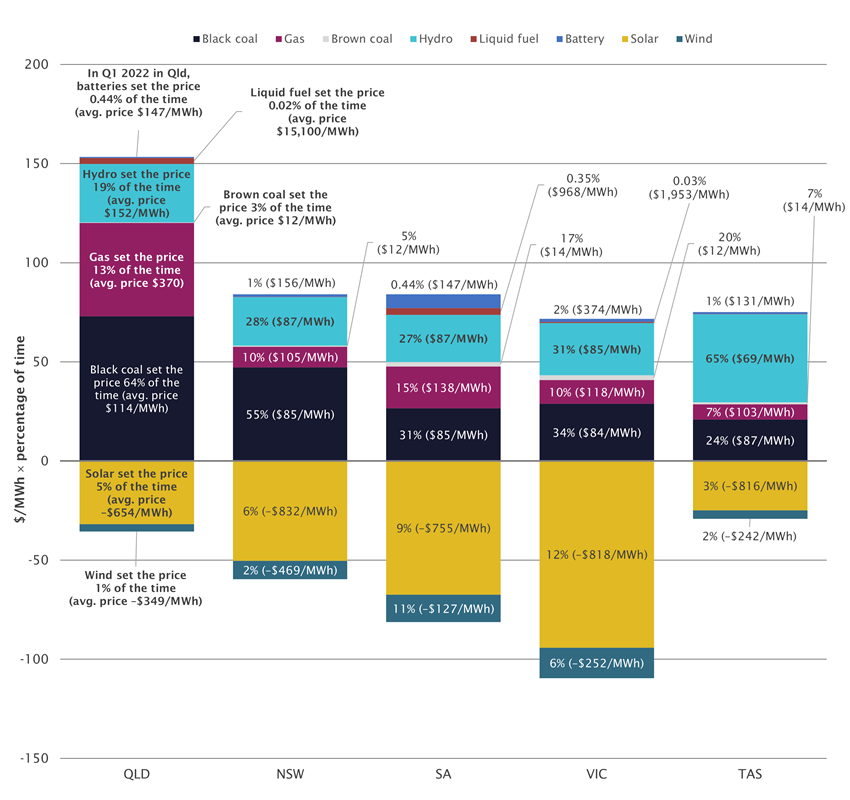
Notes: The figure
shows the percentage of time black coal, gas, brown coal, hydro, battery, solar
and wind generators that set the wholesale electricity price in each National
Electricity Market (NEM) jurisdiction, multiplied by the price set in dollars
per megawatt-hour ($/MWh). This reflects the approximate influence of each
generator type in raising or lowering wholesale prices. The sum of the time
percentages exceeds 100% and the totals differ from Figure 4 because the price
can be set by more than one fuel source at a time.
Source: Australian Energy Regulator (AER), Quarterly Price Setter and Average
Price Set by Fuel Source (Melbourne: AER, 2022); and Parliamentary Library calculations.
As explained in WattClarity’s ‘Beginner’s guide to how dispatch works in the National Electricity Market’: under normal market conditions, the Australian Energy Market Operator (AEMO) receives competing offers from power stations (‘bids’) to supply electricity in each 5-minute electricity trading interval. AEMO selects the cheapest bid first. If more electricity is needed to meet forecast demand, AEMO moves down the ‘bid stack’ and adds the next cheapest offer, and so on. All the power stations chosen in that interval are paid the same price as the highest bidder needed to meet total demand, called the ‘price setter’. In early 2022, wind and solar set negative prices on average, while batteries, black coal and gas set quite high prices (see Figure 1). Wholesale prices are very sensitive to supply and demand. Negative wind and solar prices are often due to excess production on sunny, windy days.
Gas can also play a significant price setter role
through ‘shadow pricing’ (as noted by the Australian
Competition and Consumer Commission in 2018), whereby otherwise cheaper
generators adopt a bidding
strategy that ‘shadows’ the bids of more expensive gas generators.
Both NSW and Queensland export black coal and gas,
as well as using them domestically for power generation. Therefore, local power
stations compete with potential overseas customers on price. In simplified
terms: overseas customers are willing to pay elevated prices due to shortages
created by Russia’s invasion of Ukraine (see ‘Global trade risks and opportunities’ in this Briefing book).
Domestic generators have to match these prices; they pass on their increased
fuel costs through increased wholesale electricity prices; and the impact is
worse in the electricity market regions more dependent on these commodities.
These dynamics are a factor in the 2022 east coast
energy price crisis, as explained in ‘Issues for the 47th Parliament’ below.
Recent Australian policy and legislation
During the 46th Parliament, the Morrison Government
supported the development of Australia’s coal and gas reserves – particularly
gas, under the ‘gas-fired
recovery’ policy announced in September 2020. Throughout its term, it emphasised
the need for affordable and reliable energy while maintaining Australia’s
competitive position as a top coal and LNG exporter, with initiatives
including:
Figure 2 Location of existing and potential future gas
supply and infrastructure options in the 2021 National gas infrastructure plan
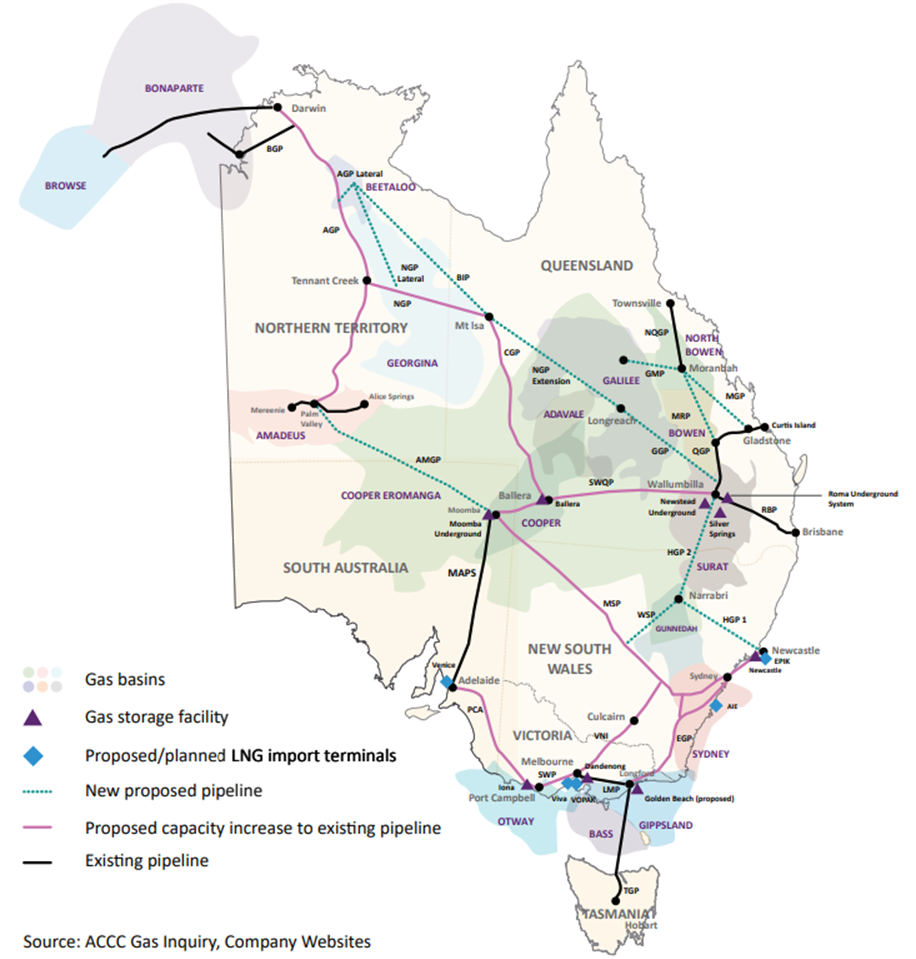
Source: Department of Industry, Science, Energy and
Resources (DISER), 2021 National Gas Infrastructure Plan, (Canberra: DISER,
November 2021), 8.
Issues for the 47th Parliament
The 2022 winter energy
crisis
The most immediate issue is energy prices in
eastern and southern Australia – that is, the eastern gas market and the ‘National Electricity Market’ (NEM) – which
are exacerbating inflationary pressures (see the article,
‘Rising inflation and macroeconomic balance’
in this Briefing book).
AEMO had been predicting an east coast gas shortage as early as
winter 2023, but the
early onset, speed and scale of current price increases (see Figure 3) have
seen a NSW gas retailer collapse and put manufacturing businesses at risk of
closure.
And while electricity price volatility is not historically unusual in the NEM (see Figure 4), the scale of the
current market disruptions has no obvious precedent, and has been described as
the result of more than a
decade of political and parliamentary failure to agree an enduring energy transition
policy.
The energy markets in the south-eastern and north-western parts of Australia follow quite different dynamics. Western Australia and the Northern Territory have their own electricity markets; the remaining states and the ACT are part of the NEM. Similarly, WA and the NT have their own gas markets, whereas an interconnected gas grid connects the eastern and southern states and territories.
Figure 3 Daily benchmark gas prices in $ per gigajoule (GJ)
for the Wallumbilla Gas Supply Hub (east coast wholesale benchmark prices)
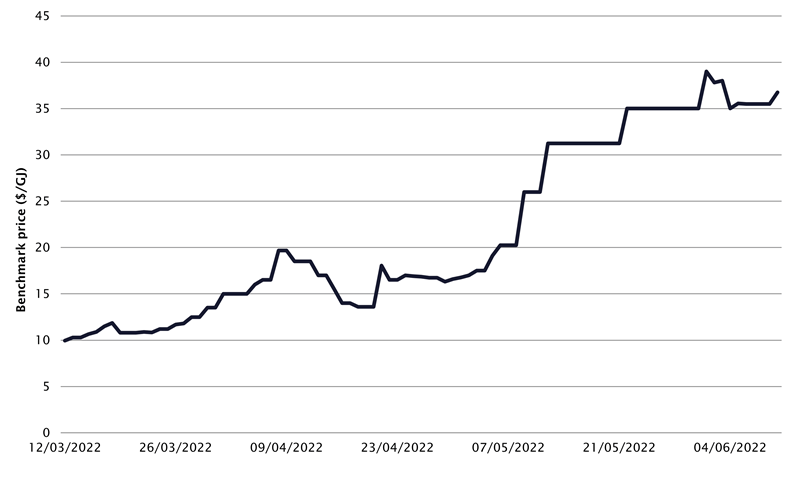
Note: The Wallumbilla Gas Supply Hub (GSH)
in southeast Queensland is a trading exchange for the east coast gas market.
Source: Australian Energy Market Operator (AEMO), GSH Data Dashboard (Melbourne: AEMO,
2022).
Figure 4 NEM quarterly volume-weighted average electricity spot
prices ($/MWh), 2005–2022
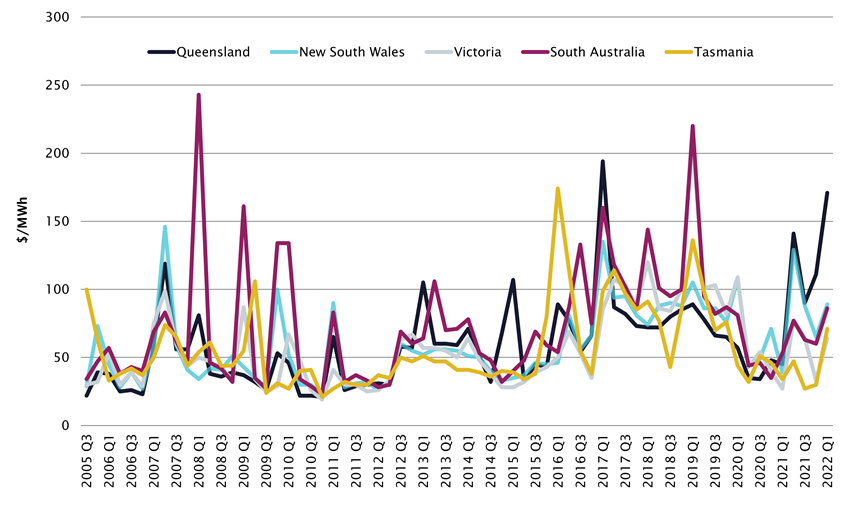
Source: AER, Quarterly Volume Weighted Average Spot Prices—Regions (Melbourne: AER, 2022).
In May 2022, the AER announced a significant
increase to the default market offer (DMO) retail electricity price to apply to most of the NEM (Figure 5). It
explained that ‘Rising wholesale costs are the main cause’, due to ‘unplanned [generator] outages and higher coal and gas
costs … compounded by the ongoing war in Ukraine’, among other factors. It
noted ‘very significant increases in wholesale futures prices for all DMO
regions but in particular NSW and Queensland.’
The default market offer (DMO) is the maximum price an electricity retailer can charge a standing offer customer each year. It is based on the retailer costs:
- to purchase electricity from power stations (wholesale costs)
- to transport that electricity to customers (network costs)
- to comply with government environmental schemes (environment costs)
- associated with serving retail market customers, such as billing and provision of hardship services (retail costs).
Figure 5 Change in the price components of the default
market offer for retail electricity between 2021–22 (DMO 3) and 2022–23 (DMO 4)
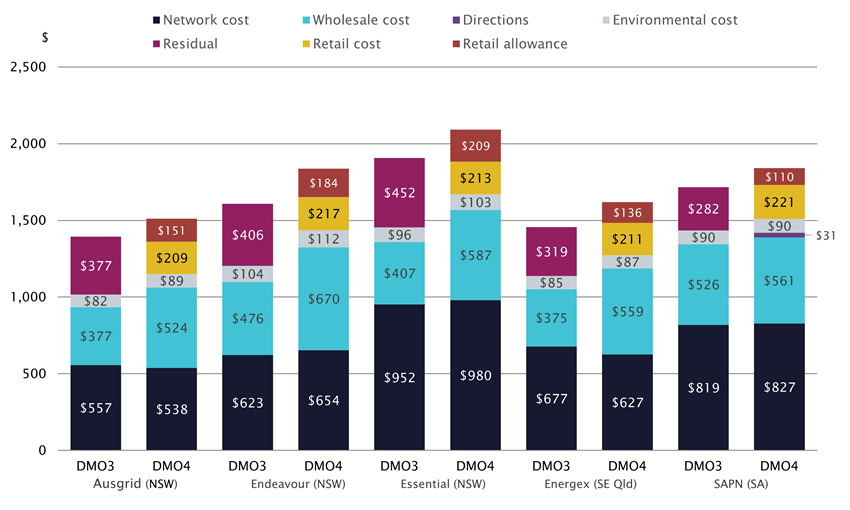
Notes: The figure
shows the change in nominal DMO price components for most residential
electricity customers. The names indicate the responsible electricity
distributor(s) in each market region. DMO 3 did not specify separate ‘retail
cost’ and ‘retail allowance’ figures; these were combined under the ‘residual’.
Source: AER, Default Market Offer Prices 2022–23: Final Determination (Canberra: AER, May 2022), 8.
The crisis deepened
and spread to the rest of the east coast over Q2 2022. AEMO intervened extensively in the gas and
electricity markets, capping gas prices in Victoria, Sydney
and Brisbane at $40/GJ, triggering its emergency Gas Supply Guarantee mechanism for the first time and capping wholesale electricity prices at $300/MWh, (at first only in Queensland- but then across all
mainland jurisdictions in the NEM). AEMO suspended the operation of the wholesale
electricity spot market across the entire NEM on 15 June, after enough generators declined to bid at or below the capped
price to risk widespread blackouts – unless AEMO ordered generators to dispatch,
regardless of their commercial preferences. The
imposition of such price caps is rare, and the suspension of the entire NEM spot
market was unprecedented.
At the time of writing, AEMO had just announced plans for a staged return to normal spot market operations. However, the broader price crisis is likely to persist, and the
best policy response is contested.
The Morrison
Government had committed to new gas infrastructure and developing new supply to
address potential shortfalls. However, AEMO warned in March 2022 that the development timescale would be too long
to address the gas shortfalls then forecast for winter 2023. Commentators have asked if the
Australian Government will exercise the ADGSM, requiring LNG exporters to redirect supply
domestically. However, the new Minister for Climate Change and
Energy and ADGSM critics have warned of the mechanism’s limitations
(see ‘The Australian Government’s ability to restrict gas exports: a quick guide’). The architect of the Morrison Government’s
‘gas-fired recovery’ (Andrew Liveris) and the Australian Industry Group have called
for an east coast domestic gas reservation policy. Others have called for additional new gas development to
increase supply and for
the construction of LNG import terminals.
Some policymakers support the inclusion of coal and
gas generators in the Energy Security Board’s proposed ‘capacity mechanism’, which is intended to create an explicit financial incentive for generators
in the NEM to guarantee capacity during at-risk periods, but this is disputed between the NEM states and territories and within the 47th Parliament.
Many also see the
crisis as compelling evidence for why Australia
should accelerate its transition away from coal- and gas-fired electricity and gas-based heating and cooking and into
zero-emissions, cheaper renewables – including investing in batteries and
transmission to support reliability (see the article, ‘Electricity sector: continuing modernisation’, in this Briefing book). At the time of writing, the exception to 2022 east
coast price pressures was the ACT, whose long-term contracts for a 100% renewable
electricity supply shielded it
from issues affecting coal and gas power. The ACT’s Independent Competition and
Regulatory Commission suggested that ‘the average annual bill for Canberrans on standing offers will
be the lowest compared to the
average standing offer bills faced by customers in NSW, Victoria, Queensland
and South Australia’.
Other unresolved issues on the road to net zero
Over the medium to longer term, debate about
whether, where and how Australia should continue to invest in new fossil fuel energy
– for domestic use or export – pivots on whether the benefits justify the
future carbon dioxide and methane emissions. Although ‘ending the climate wars’
was a key narrative during the 2022 election campaign, the 47th Parliament
nonetheless inherits unresolved debates about coal and gas in the context of
decarbonisation, additional to the employment, electricity generation and gas
supply issues canvassed above.
Scope 3 emissions: Under
current Australian legislation, domestic decarbonisation (for example, modernising
the electricity supply to renewable sources) can be pursued without regard to ‘scope
3’ emissions by overseas end consumers of Australian fossil fuel exports.
Existing emissions reduction mechanisms such as the climate
safeguard mechanism apply only to domestic emissions. Fugitive
methane emissions (or leakage) from coal or gas extraction ‘count’ for the
purposes of the safeguard mechanism, but not the much
greater scope 3 emissions released when the fuel is burned by end users
overseas. The Australian
Centre for Corporate Responsibility has called for greater attention to such
scope 3 emissions when assessing corporate carbon footprints. While the
incoming Albanese Government has announced it will strengthen
the safeguard mechanism, there has been no indication it will fundamentally
revise the framework to consider scope 3 emissions. (On emissions reduction
policy generally, see the article, ‘Climate change and emissions reduction’ in this Briefing book.)
CCS: Debates around
Australian Government support for coal and gas industry CCS projects may also
continue. The International
Energy Agency (IEA) and Intergovernmental
Panel on Climate Change (IPCC) have reported that carbon sequestration will
be required on a massive scale to limit warming, including through CCS. The
past few years have seen a surge
in global interest in CCS and other
carbon dioxide removal technologies, but the IPCC’s 6th Assessment report nonetheless
warns that current
global rates of CCS deployment are insufficient to achieve net zero by
mid-century.
In Australia and some other OECD countries, a social
licence for CCS is undermined by perceptions it is being used by fossil fuel
industries as ‘a device for mitigation obstruction’ – or more plainly, ‘greenwashing’.
Australian parliamentary
debate on the merits of CCS has been fraught. Opponents have noted that CCS’s
technical
and commercial track record to date is underwhelming, and Australian critics
particularly note Chevron’s
failure to capture the agreed share of Gorgon project emissions under its WA
environmental approval. Some support CCS research and development in principle,
just
not when used to prolong fossil fuel industries.
Legislation governing new fossil fuel
development: During the 46th Parliament, independents
and minor parties pushed for legislative debate on limits to fossil fuel development
beyond the policies of the incumbent government. This pattern may continue. For
example, the Australian
Greens introduced multiple Bills seeking to stop new fossil fuel development and
increase taxes on big emitters, and sought to bring
climate change considerations into the scope of the Environment Protection
and Biodiversity Conservation Act 1999. An independent introduced
a Bill to block the offshore ‘PEP11’ project, and One
Nation introduced a Bill requiring offshore petroleum regulators to take into
account the benefit to the Australian community when granting new leases or
renewing existing leases.
Environmental
approvals: The Australian
Government’s role in environmental approvals for major fossil fuel projects – particularly
offshore projects where the underlying resource is federally owned (rather than
owned by the states) – is also likely to face growing scrutiny. Opponents have
referred to planned coal and gas development projects as ‘climate bombs’. Further litigation
against Australian Government environmental approvals for new fossil fuel
development on climate change grounds is expected, including an attempt
by Tiwi Islanders to block the offshore Barossa project in the Federal Court,
continuing the trend set by the 2021 case of Sharma v Minister for the Environment.
With this complex political backdrop, and the urgent
problems of both energy costs and climate change, it has the potential to be a
challenging but pivotal Parliament in Australia’s history.
[1] Estimates using Labour Account Australia
data
are slightly higher for coal mining and lower for oil and gas extraction.
[2] This still excluded
indirect employment tied to domestic uses of coal and gas, for example jobs in
local construction projects or manufacturing that use Australian steel as an
input, or jobs in coal- and gas-fired power stations and their satellite
communities.
Back to Parliamentary Library Briefing Book
For copyright reasons some linked items are only available to members of Parliament.
© Commonwealth of Australia

Creative Commons
With the exception of the Commonwealth Coat of Arms, and to the extent that copyright subsists in a third party, this publication, its logo and front page design are licensed under a Creative Commons Attribution-NonCommercial-NoDerivs 3.0 Australia licence.